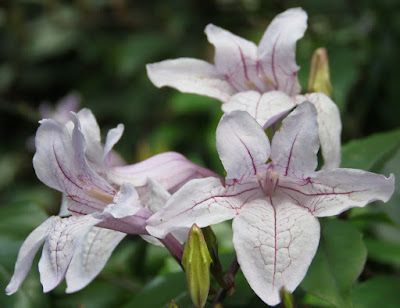The Irishman's beautiful South African plant
The 'bella' part is clearly are reference to this plant's beauty (you'll recall of course that rather attractive seaweed, Entwisleia bella), while Mackaya celebrates the botanist James Townsend Mackay, founder of Trinity College Botanic Garden in Dublin and author in 1836 of Flora Hibernica (Hibernica being Ireland).
While I don't think Mackay has anything to do with South Africa or this plant, it was named after him by compatriot William Harvey, who collected plants from the Cape in the 1830s, writing a flora of the region with Otto Sonder (the gentleman who sold my predecessor Ferdinand Mueller 300,000 or so specimens from his massive herbarium).
So as with Entwisle's beautiful alga, this name can be read as Mackay's beautiful shrub. Also like Entwisle's alga, there is only one species in this genus. Although, unlike that algal beauty, there are many more genera in Mackaya's family, Acanthaceae, such as the Oyster Plant (Acanthus mollis).
The beauty in this plant, also called the Forest Bell Bush, is mostly to do with its flowers. Out of flower it's a compact shrub or small tree with quite nice dark-green leaves but nothing to earn the epithet bella.
A curious, but perhaps not particularly beautiful, characteristic of these leaves is an ocassional 'hairy pocket' on the undersurface, where the veins in the leaves connect. This is a picture I took back in my office using a small magnifying lens attached to my phone...
It's actually a little dimple, which you can see poking through as pimple-like projections on the upper surface in this next picture.
It's actually a little dimple, which you can see poking through as pimple-like projections on the upper surface in this next picture.
I'm presuming these pockets provide homes to insects that on the whole are beneficial to the plant. Certainly the flowers attract plenty of insect visitors, including most notably in South Africa, the Blue Pansy Butterfly.
And it's the veins that deserve mention here as well. In the flowers, the beautiful flowers, the petals like a thin parchment or membrane etched with purple veins.
They say, and it seems to be true in Melbourne Gardens, it does best in shade but flowers more with sun. It's clearly a tough plant and one that we use a bit as a filler around the botanic gardens, but odd that it isn't in more gardens. Perhaps that's because it's considered 'rather old fashioned'. Climate change may well bring it back into fashion but could also encourage its potential as an environmental weed (it is already one in New Zealand).






Comments
If you are looking for any indoor house plant, office plant details on web then you can find all types of details here you can see this blog as free resources and guides which will help you to improve your knowledge about how to choose plants how to decorate your house, room or office choosing perfect plants and improve in atmosphere and air quality.
indoorplants24 house plant care propagation guide